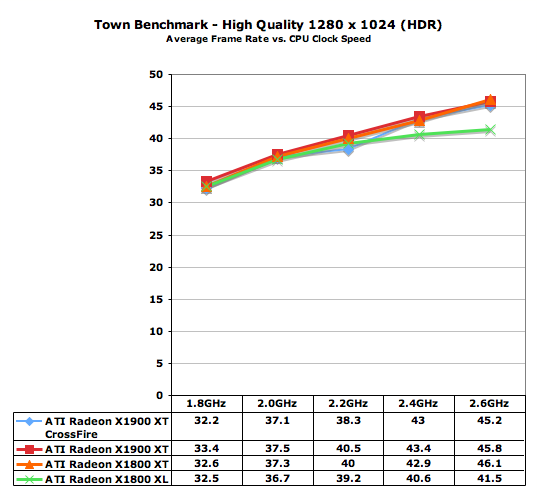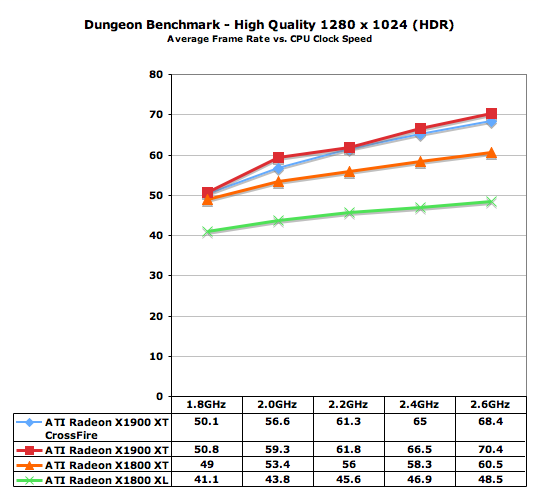The Elder Scrolls IV: Oblivion CPU Performance
by Anand Lal Shimpi on April 28, 2006 10:00 AM EST- Posted in
- CPUs
GPU Performance vs. CPU Clock Speed
For these tests, we took a single core AMD Athlon 64 (1MB L2) and increased its clock speed from 1.8GHz all the way up to 2.6GHz, measuring performance at each step of the way. The image quality settings haven't changed; what we're looking for here is if there's a pattern in the CPU/GPU relationship.
We picked four GPUs to look at their CPU dependency: the Radeon X1900 XT CrossFire, X1900 XT, X1800 XT and X1800 XL. We chose these four configurations because they represent the best ultra high end, high end, upper mid-range and mid-range GPUs for Oblivion. Our main interest is in finding out if there is a point at which the best mid-range GPU ends up being faster than the best high end GPU because of being paired with a faster CPU, or if having a faster GPU is really all that matters in Oblivion.

What this graph proves is that our Oblivion Gate benchmark is really only CPU bound if you've got a pair of X1900 XTs in CrossFire. What this does mean is that if you've got a low end Athlon 64, you won't see much of a performance difference between a single X1900 XT and a pair of them running in CrossFire mode. But for the most part this benchmark is no different than what we've seen from other games, with the X1900 XT, X1800 XT and X1800 XL being basically GPU bound - let's see if our other two tests show the same picture.

The Town benchmark is extremely CPU bound as you can see by this graph, and in Oblivion you do spend quite a bit of time walking around in towns. Being able to isolate the individual lines in this graph isn't very important because they basically all show the same thing, but what is important is to be able to look at the graph two dimensionally. What this graph shows us is that a single X1800 XT paired with a 2.4GHz CPU offers much better performance than an X1900 XT with a 1.8GHz Athlon 64, thus stressing the need to have a balanced CPU and GPU setup in order to avoid wasting money on a fast GPU. We already saw in our GPU performance article that CrossFire (and SLI) do nothing for performance in our Town/Dungeon benchmarks so the behavior here is not surprising.

Much to our surprise, the Dungeon benchmark ended up being a lot more GPU bound than the Town test but the conclusions we can draw are very similar. The Radeon X1800 XT does extremely well when paired with a high end CPU and will actually offer the same performance as a Radeon X1900 XT with a lower end or mid range CPU; it isn't until you give the X1900 XT a faster CPU as well that it can really stretch its legs and offer the performance advantage we know it has over its predecessor.










36 Comments
View All Comments
kmmatney - Saturday, April 29, 2006 - link
If you look at the Tom Hardware charts, plot the performance of the 256K cache Semprons on a chart, and then extrapolate to higher frequencies, a Sempron at 2.45 GHz will perform better than the Athlon 3500+, and closer to the Athlon 3700+. It does start to fall back a little in the heavy multitasking benchmarks, but for gaming and content creation its very close to an Athlon 3700+.For instance, if you take the Far Cry benchmark at 1280 x 1024 (other benchmarks behave the same):
Sempron 256K 1.4 Ghz = 126.9
Sempron 256K 1.6 Ghz = 140.0
Sempron 256K 1.8 Ghz = 151.6
Sempron 256K 2.0 Ghz = 162.7
This forms a linear curve with very little drop-off with speed increase
Now extrapolate to 2.4 GHz
Sempron 256K 2.4 GHz = 186.95 (predicted)
Sempron 256K 2.45 GHz = 189.95 (predicted)
Sempron 256K 2.5 GHz = 192.9
Athlon 3700+ San Diego: 190.9
Athlon 3500+ Venice : 186.2
Athlon 3200+ Venice : 176.5
For a given amount of money, an overclocked Sempron paired with a high end video card will give you the best bang-for-buck for gaming.
JarredWalton - Saturday, April 29, 2006 - link
I'm not talking about as an overall platform; I'm talking specifically about Oblivion performance. Clearly, looking at the 3500+ vs. 3700+, the jump from 512K to 1024K L2 helps quite a bit. Looking at Celeron D, 256K and a lower FSB kills performance. It's not too much of a stretch to guess that Sempron chips will do proportionately worse in Oblivion than in many other games/applications.kmmatney - Saturday, April 29, 2006 - link
Also, the low end S939 Athlon 64s have come down in price, with the cheapest now at $109, so right now, I would agree that Socket 939 is the way to go now, even for a low end system.If you look in the area of the game that counts, the outdoor scenes, the extra 512K of cache gives you an extra 2 fps. An educated guess would put a Sempron 3100+ running at stock speeds at 28.5 fps. Overclocked to 2.4 Ghz it would be around 35 fps. Not great, but very playable.
JarredWalton - Saturday, April 29, 2006 - link
True, you won't notice 2 FPS difference. The thing is, a few people are talking about overclocked Sempron versus stock clock speed Athlon 64. If you're going to overclock one, you have to overclock the other. My experience is that socket 939 overclocks far better than socket 754, the so a lot of those Athlon 64 3000+ chips can hit 2.5 to 2.7 GHz on air cooling.JarredWalton - Saturday, April 29, 2006 - link
Oops -- posted too soon.You might be talking about five to 10 frames per second difference at that point, which would definitely be noticeable. Of course, if you're looking at running a Sempron with the typical PCI express or AGP card, you will likely be GPU limited anyway. Even a GeForce 7600 GT is going to struggle with the outdoor scenes.
Powermoloch - Friday, April 28, 2006 - link
Yeah, I was wondering about that too :). My gaming rig is being powered by 3100 sempron paris and I did overclocked it @ 2.069 Ghz. Oblivion went out pretty fine at most times, and I'm really enjoying the game.